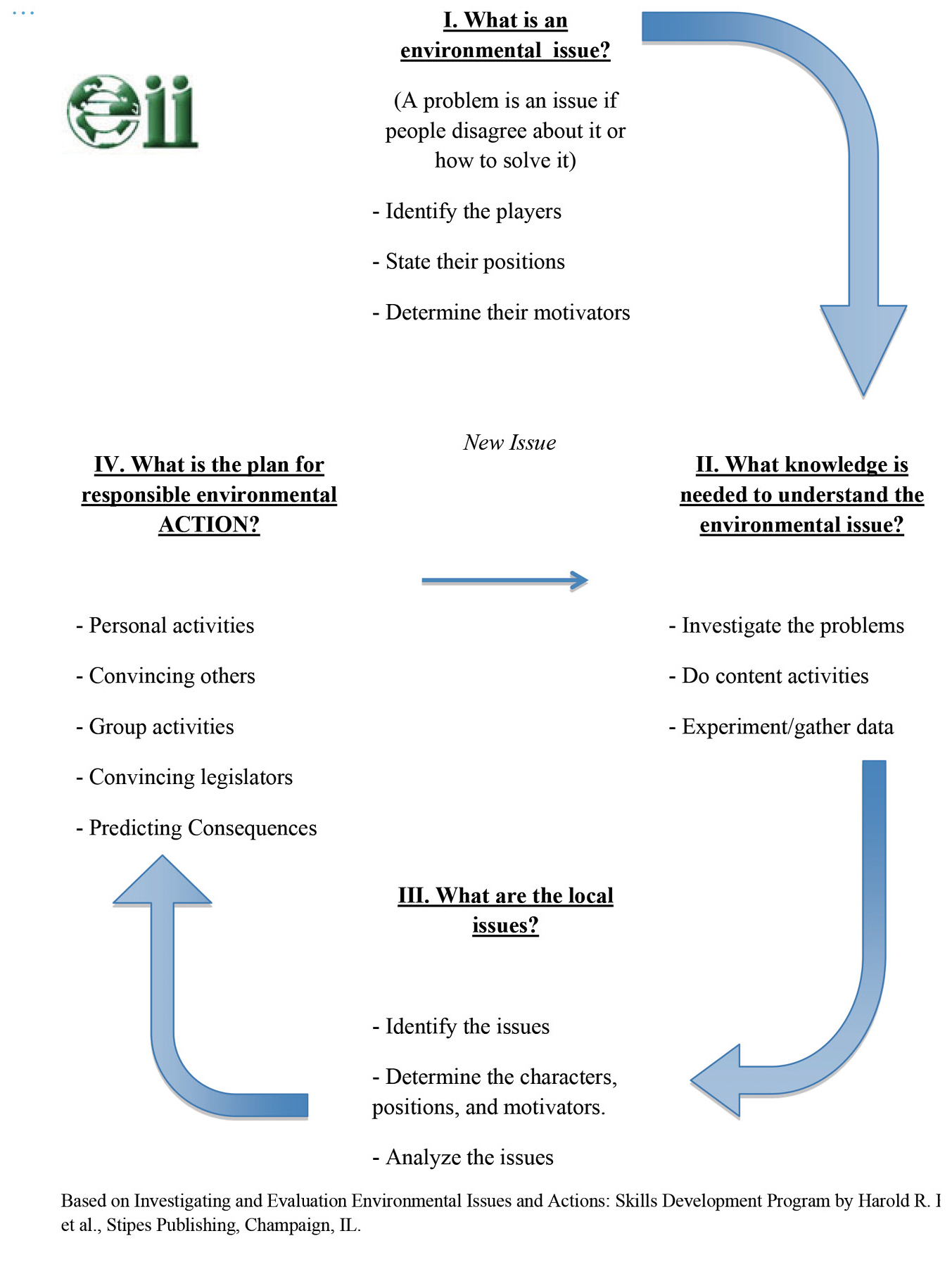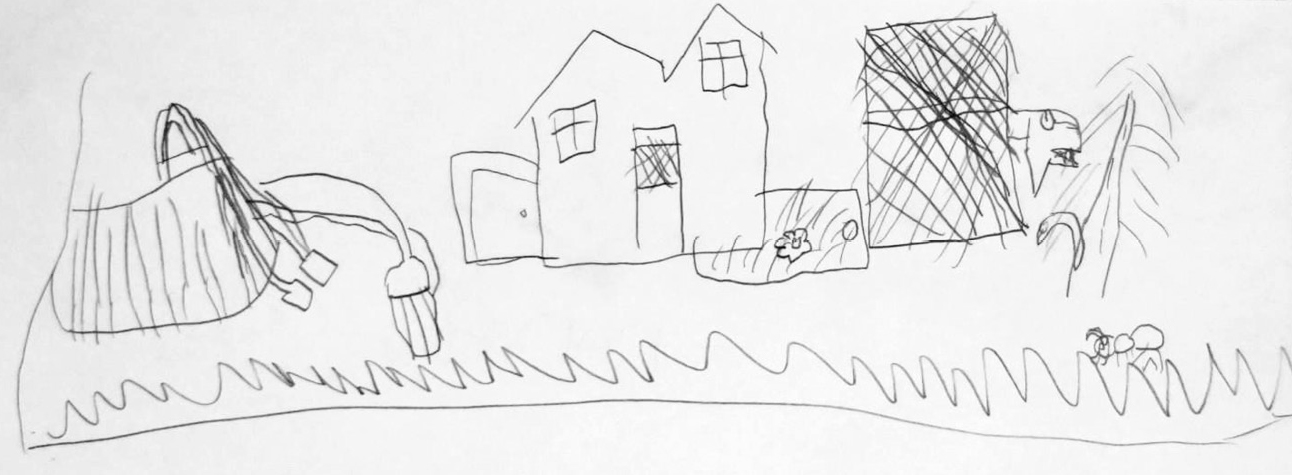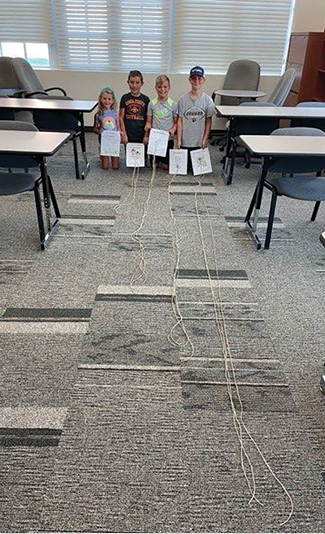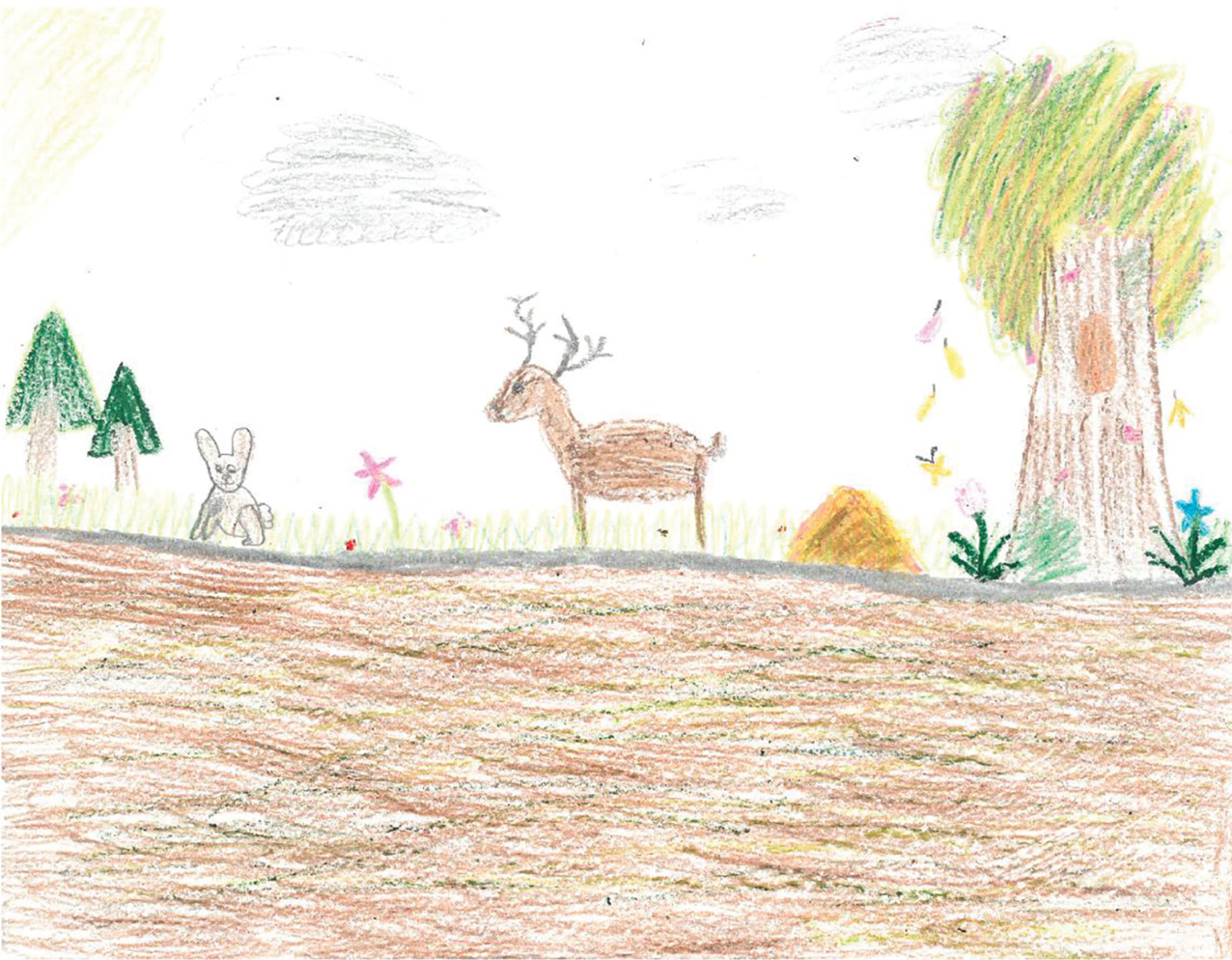Cross-Curricular Connections
Where Does Your Sidewalk End?
Third-grade classroom students expand awareness of their local environment
Science and Children—November/December 2021 (Volume 59, Issue 2)
By Barbara Ehlers and Benjamin Forsyth

Environmental Issues Instructional (eii) model of issue investigation.
In the world of cell phones and video games, it is no wonder children do not spend much time outdoors. Can we entice them by studying what’s around them? We used a unit about the prairies of Iowa to help third graders learn about their local environment. Using the Environmental Issues Instructional Model (Figure 1), the unit met science and literacy standards with activities inside and outside the classroom.
Wildlife of Prairie Roadsides
The 14 lessons focused on biotic and abiotic interaction in our environment, past and present, based on the theme, Wildlife of Prairie Roadsides. Students learned about plants and animals extending “beyond their sidewalk” in and out of the classroom. Alignment of activities with Common Core Literacy Standards, Next Generation Science Standards, and the Environmental Issues Instruction (eii) model is shared online (see Supplemental Resources). The eii instructional model includes four levels: Level I: What is an environmental issue? Level II: What ecological concepts are needed to understand this issue? Level III: What are local environmental issues related to this theme? Level IV: What responsible environmental action could be taken related to this environmental issue?
Introduction
To begin, we read Silverstein’s Where the Sidewalk Ends (1974). As the students re-read the poem to comprehend the meaning and relate it to the study of the outdoors, they chose words from the poem and created living and nonliving categories. Great discussion ensued about what is alive and what is not. “An apple is not alive, because it is no longer growing, but it once was.” “Anything that is green is alive.” “What in the world is peppermint wind?” “Is the wind alive—it moves things?” Next, the students drew where their own sidewalk ended. They drew backyards with swing sets, swimming pools, and doghouses (see Figure 2). It was obvious that it is less common for children today to play in streams, woods, and grassy areas, which explained their drawings. Where their sidewalk ended was very close to civilization. David Sobel (2008) suggests that children are not connected with outdoor surroundings, which affects thinking about environmental issues. We were hoping this environmental issues unit would help our students connect to nature and address this disconnect with the outdoors.

Exemplar of students’ first “Where the Sidewalk Ends” drawings.
Level I: What Is an Environmental Issue?
We read and acted out Dr. Seuss’s The Lorax (1971) to learn the difference between an environmental problem and environmental issue. The room filled with laughter and joyous sounds of truffula trees swaying in the breeze, brown barbaloots dancing and singing, swomie swans flapping their wings, and humming fish humming in the pond. The Lorax and the Once-ler spoke their views loudly and clearly. Using a graphic organizer, we analyzed the story, looking at different perspectives and motivations toward environmental problems and issues by the Lorax and the Once-ler. A major concept explored was how disagreements about solutions to environmental problems become environmental issues. Learning about motivations behind actions in the story was intentional to help students see why people take stands within environmental issues. These differences between problems and issues were revisited in Level III.
In addition to analysis of environmental problems and issues in The Lorax, students noted literary elements and living and nonliving factors within the story. It was a great example of using text to locate information and provide evidence for answers, showing comprehension.
Level II: What Ecological Concepts Are Necessary for Understanding?
In the second level of the instructional model, the students learned science content needed to understand the theme of Wildlife of Prairie Roadsides by completing the following:
Video and writing activity. We wanted students to understand what created Iowa’s native prairies and how they changed through the years. We watched a 25-minute film, A Tallgrass Prairie Revival (Iowa Living Roadway Trust Fund 2006). Students learned historical aspects of Iowa’s prairies and how prairie alterations changed plants and animals. They saw native plants like turk’s cap, big bluestem, and animals like prairie chickens and bison that used to roam the Iowa prairies. The video gave a great visual of the living aspects of Iowa prairies and background for understanding the prairie ecosystem.
Vocabulary activity. In reading What is a Prairie (Betz 1977) the first time, students highlighted words they were not familiar with so we could discuss the meanings to better understand prairies. Words often included by the students included perennial grasses, herbaceous plants, drought, vegetative, precipitation, prairie remnants, humus, and cultivated. They used context clues and discussion to determine the meanings of the words and to better understand the content for the second reading. Next, students researched nonliving factors including precipitation, soil depth, temperature range, wind range, grass height, and fire. Students experienced gathering information from additional texts and produced graphs representing the information that differentiates prairies from other types of ecosystems. Reading the texts and graphing the information helped students understand these vital factors that describe a prairie.
True/False Booklets. Our goal of integrating science and literacy used a copy/change method in which students developed their own writing by modeling the style of a trade book using the True and False series by Scholastic. Teachers should allow plenty of time for the students to read the originals as they delight in trying to trick their peers. After reading several True or False examples, students were excited to create their own. The students became experts on specific prairie animals by reading print and electronic resources. After gathering information on the graphic organizer, students took great delight in writing true or false statements about their animals that might trick their classmates. Upon completion, booklets were displayed for all to read. Students took great pride in their booklets and relished rereading them. This gave them a solid understanding of native animals and habitats and opportunity to write informative texts and convey ideas and information clearly.

Graphing Prairie Roots. To deepen students’ understanding of prairie ecosystems, we read What Do Roots Do, which illustrates the importance of roots to plant growth (Kudlinski 2007). We displayed posters showing root lengths of different prairie plants and used jute string to create three-dimensional graphs of prairie roots. By doing so, students were able to see how the extreme lengths of prairie roots benefit prairie ecosystems. To say they were astounded by the length of prairie roots such as blazing star and compass plant compared with Kentucky blue grass would be an understatement.
Prairie Field Trip. Enough inside learning, it was time to venture outside and observe real prairie plants and animals, so we took a field trip to a prairie plot located near the middle school. It was late spring, so students were able to experience a variety of emerging plant life. We used field guides to identify the sprouting species. It was an excellent time to use vocabulary terms such as forbs, grasses, introduced, exotic, and invasive species. They were delighted to find plants they had seen on the roots poster and animals they had read about in their research. They did spot a mouse, a rabbit, robins, and goldfinches, the Iowa state bird. We did not see a deer but did find evidence of their tracks and a path through the prairie plot. The students also remarked that the prairie did not look like their backyards. The grasses were taller and uneven. They noticed the forbs were spread throughout the other plants, not all of the same kind together like in a flower garden. They begged to return to see the emerging plants as they grew taller. The students chose one grass and one forb to sketch in the field and research later. That information gave them background information for the next activity and another opportunity to use prairie vocabulary.
Create A Prairie Plant. After studying and researching existing prairie plants, we challenged the students to engineer a plant that could exist in a particular habitat. They had to construct an argument to explain how the new plant could survive under certain conditions: low rainfall, high rainfall, sandy soil, rich soil, low temperatures, and high temperatures. They met the challenge with glee! They included wide cupped leaves to capture water in low rainfall, larger stems to soak up water from high rainfall, short stems to allow growth in sandy soil, extra layers of leaves to withstand colder temperatures, and perforated leaves to withstand high temperatures. Some constructed combination plants, such as a pepper–tomato that would conserve space in dry conditions. Of course, most had very long roots. The students proudly displayed their plants in the classroom and explained the special qualities of each.
Level III: What Are Local Environmental Issues?
In Level III, we analyzed a local issue by discussing a newspaper article about whether Iowa should control deer populations. Our students could relate because deer are prevalent in Iowa, especially on highways. The newspaper article was analyzed in the same way as The Lorax during Level I, noting the characters and motivations. We assigned groups of students to take the point of view and motivation of one of eight people in the article and asked this central question: Should Iowa control the whitetail deer population? The eight individuals, organizations, and points of view in the article include:
- Merwing Briggs: deer eat trees, fruit, and vegetation
- Dennis Black, Iowa state senator: some Iowans want less deer, some do not
- Tom Lichtfield, Iowa Department of Natural Resources: Deer are difficult to count and are plentiful in some areas but not others
- Randy Taylor, Iowa Bowhunters Association: favors deer management
- Association of Fish and Wildlife: hunting licenses bring in revenue for state
- Ace Hendricks, Iowa Woodland Owners Association: deer ruining trees
- Scott Falb, Iowa Department of Transportation: deer cause many accidents
- Dana Chittick, Insurance Agent: deer cause damage to vehicles and people
Our students held excellent discussions and answered the question from their characters’ perspective. Reading a newspaper article may be challenging for some students, so we had an initial discussion about the issue topic and highlighted the section we wanted each group to focus on (that person’s motivation and point of view). The final discussion centered on their recommendations about controlling deer populations. Some saw no reason to control the deer population, while others were adamant there are too many. Some favored more hunting seasons, while others did not. Given guidance, our students were able to look at various points of view about a local environmental issue.
Level IV: What Responsible Environmental Action Will We Take?
In Level VI, students brainstormed ideas for environmental action. It is crucial for students to come up with their own environmental action plan to be enthusiastic about carrying it out. Their initial list was extensive, but we had to be realistic about what we could do in their immediate surroundings.
We decided to focus on an overgrown prairie planting on school grounds. A field specialist from a local environmental organization toured the grounds and suggested rejuvenating the prairie garden would benefit pollinators. Our third graders enthusiastically weeded, mulched, trimmed, and spruced up the prairie garden. If the amount of dirt and mud on their hands, legs, shoes, arms, and faces was any indication, it was a success! They were very proud of the action taken to improve surroundings and provide for the needs of local plants and animals. One student remarked, “This is a good start, I hope we can add to this in the future.”
Where the Sidewalk Ends
In closing, we reread Where the Sidewalk Ends, and redrew where their sidewalks ended (Figure 3). The results were amazing! Drawings included animals and flowers, trees, and shrubs, the prairie plot weeded, trimmed, and spruced up. Others drew their own backyard with a swing set or sandbox, including animals; deer, raccoon, and skunks. It was clear in their drawings that ideas of where their sidewalk ends had definitely expanded.

Exemplar of students’ last “Where the Sidewalk Ends” drawings.
Supplemental Resources
Standards connections and other unit materials are available at https://bit.ly/2Z5iesI.
Barbara Ehlers (ehlersb@uiu.edu) is an associate professor at Upper Iowa University in Fayette. Benjamin Forsyth is an associate professor at University of Northern Iowa in Cedar Falls.
Instructional Materials Interdisciplinary Literacy Elementary


